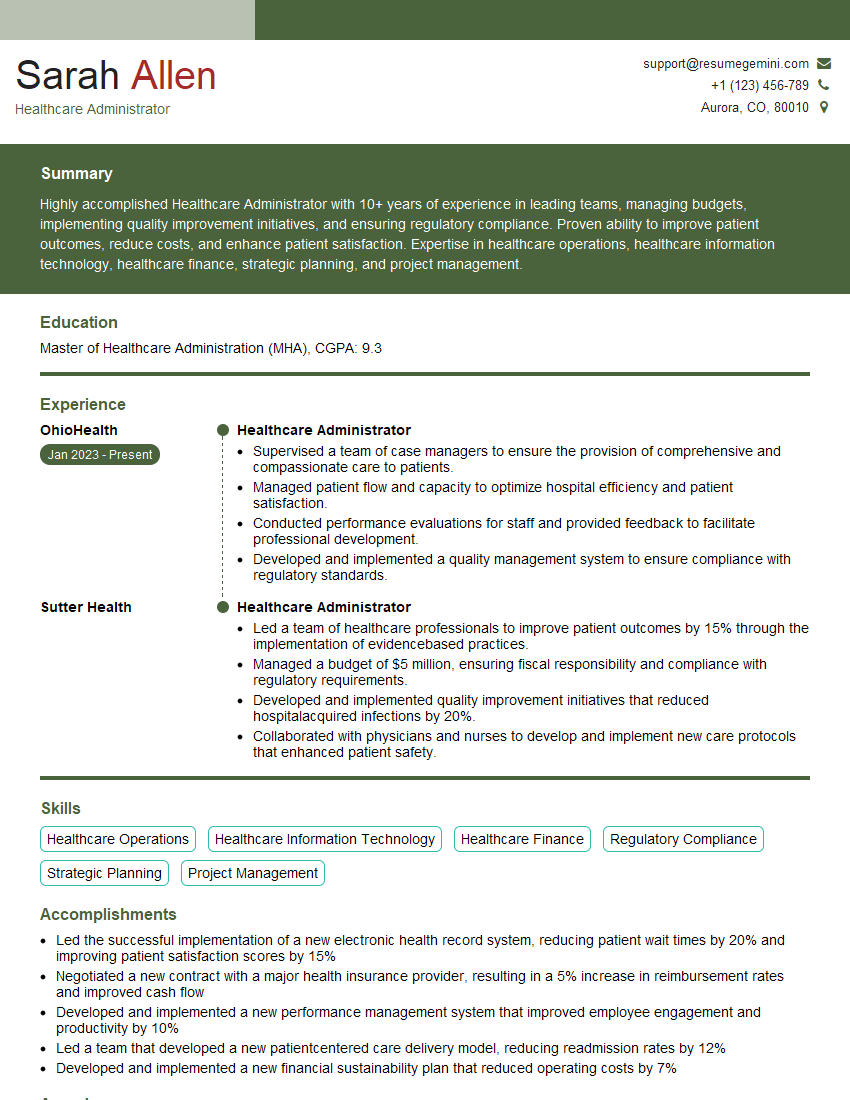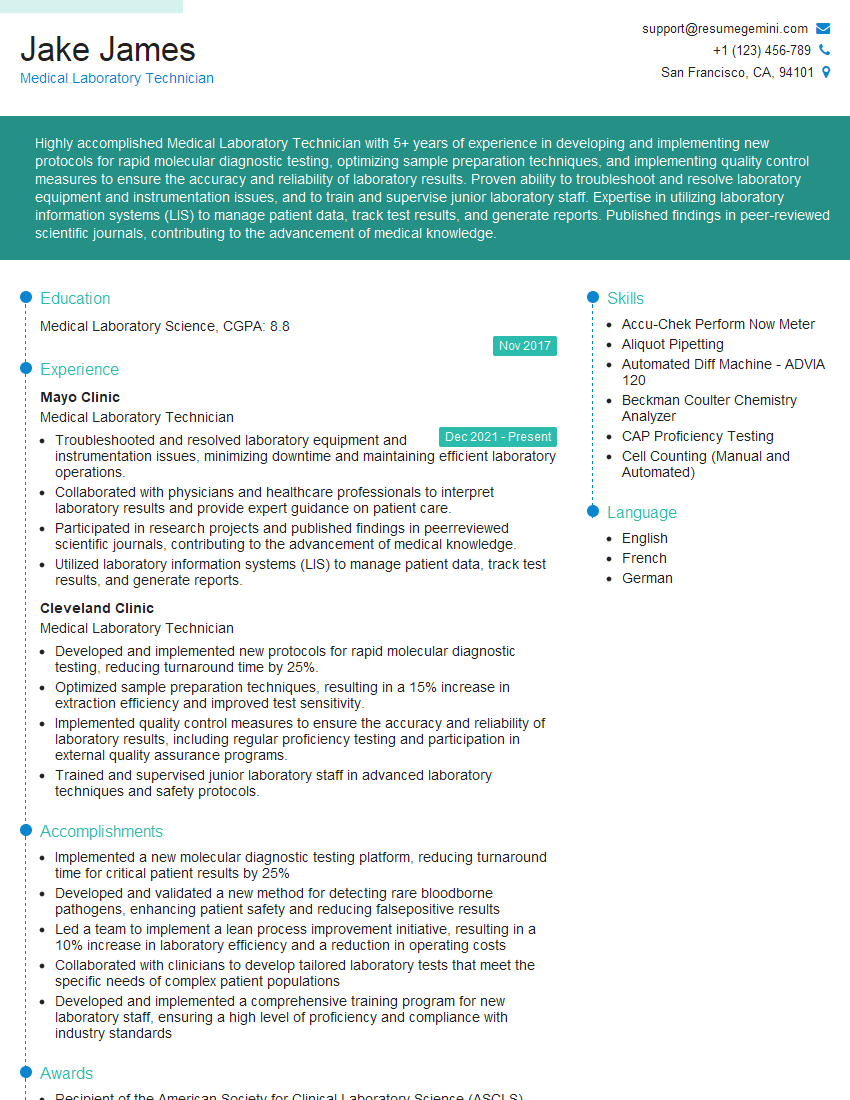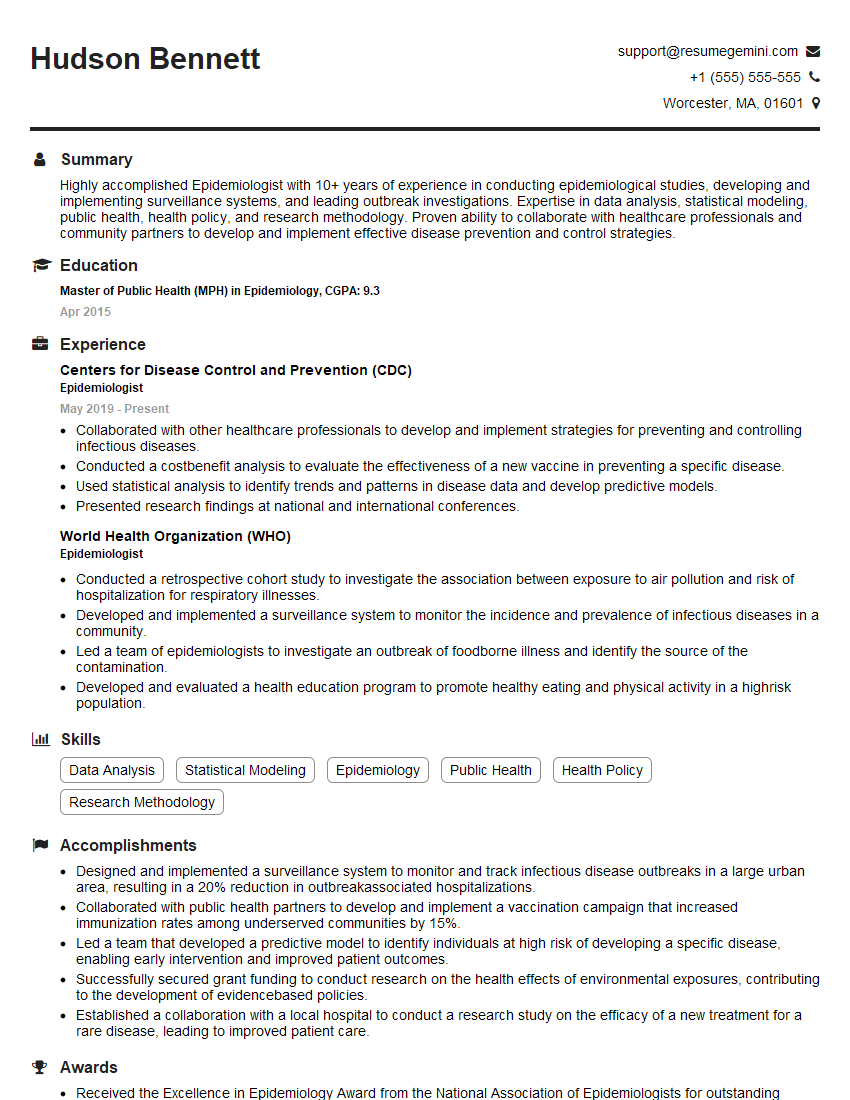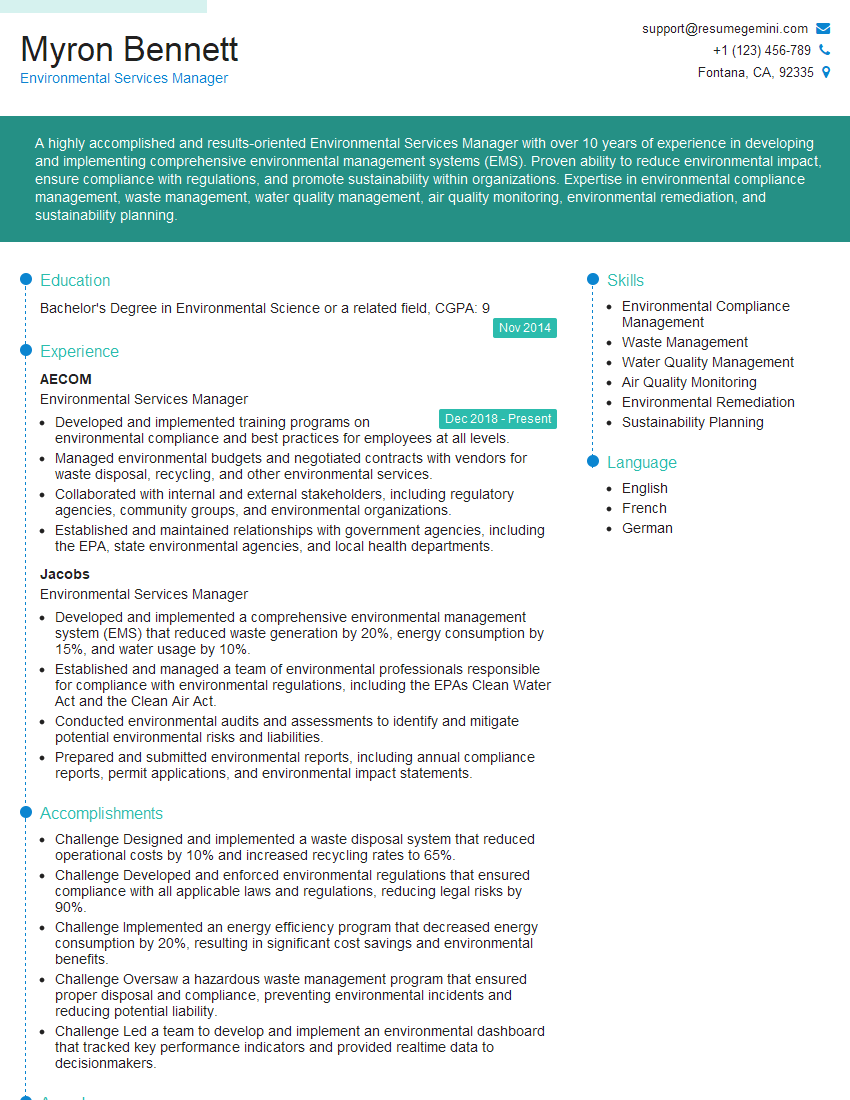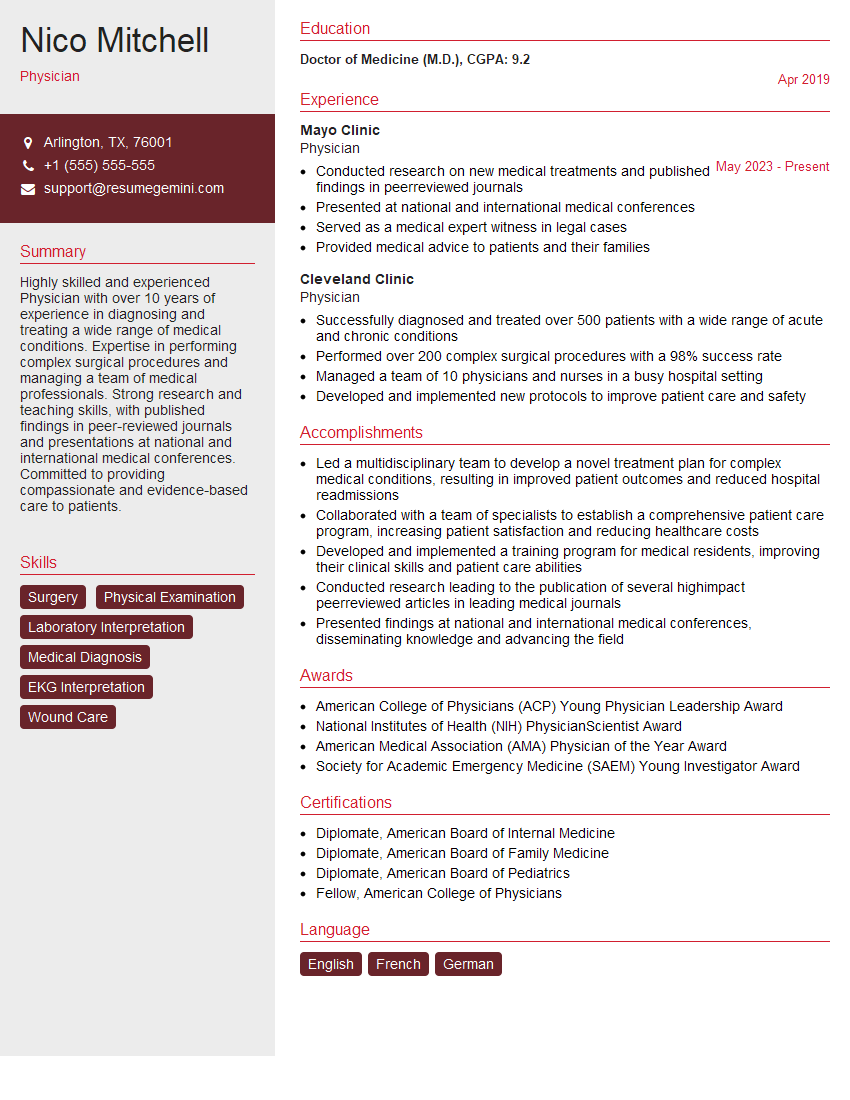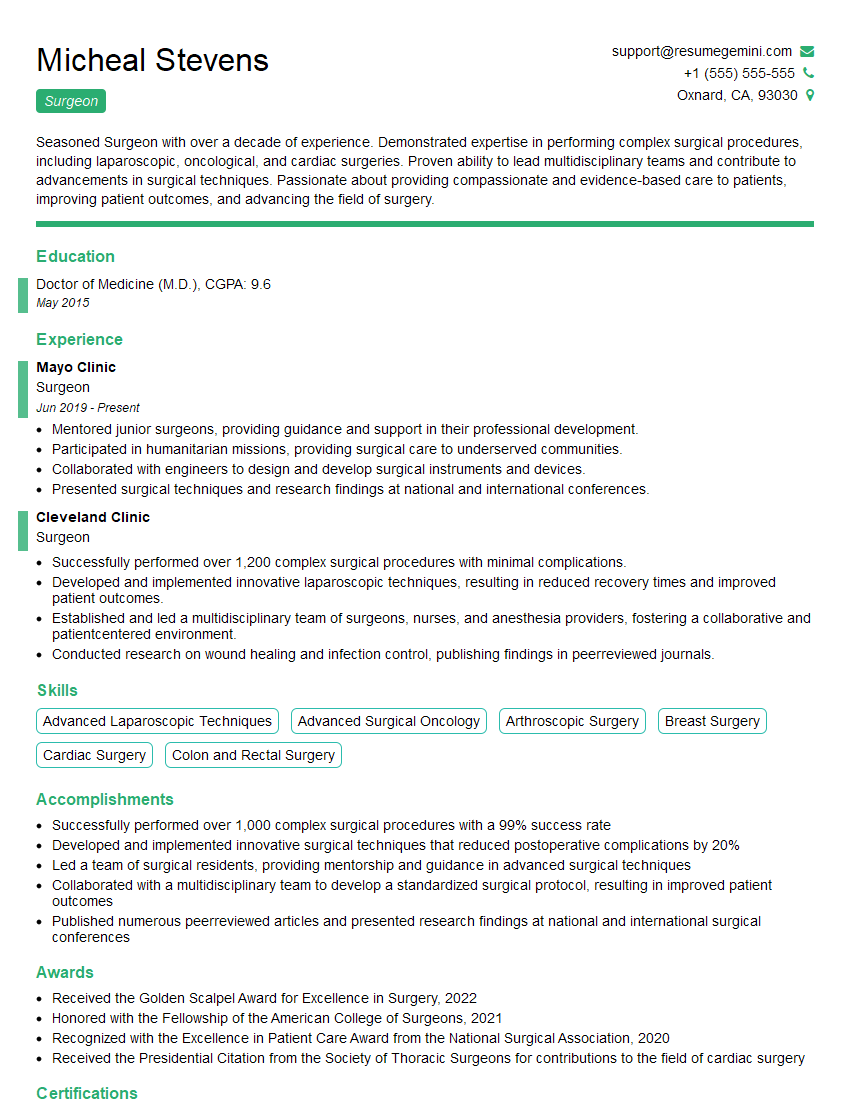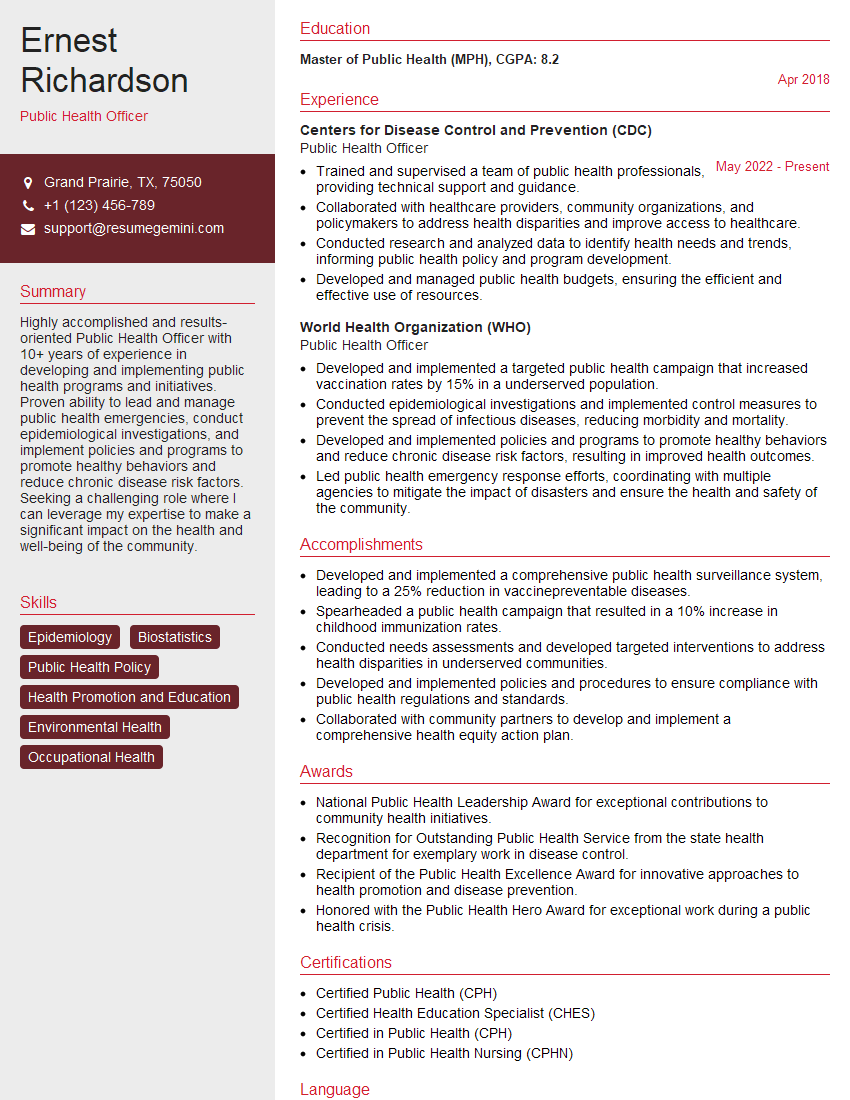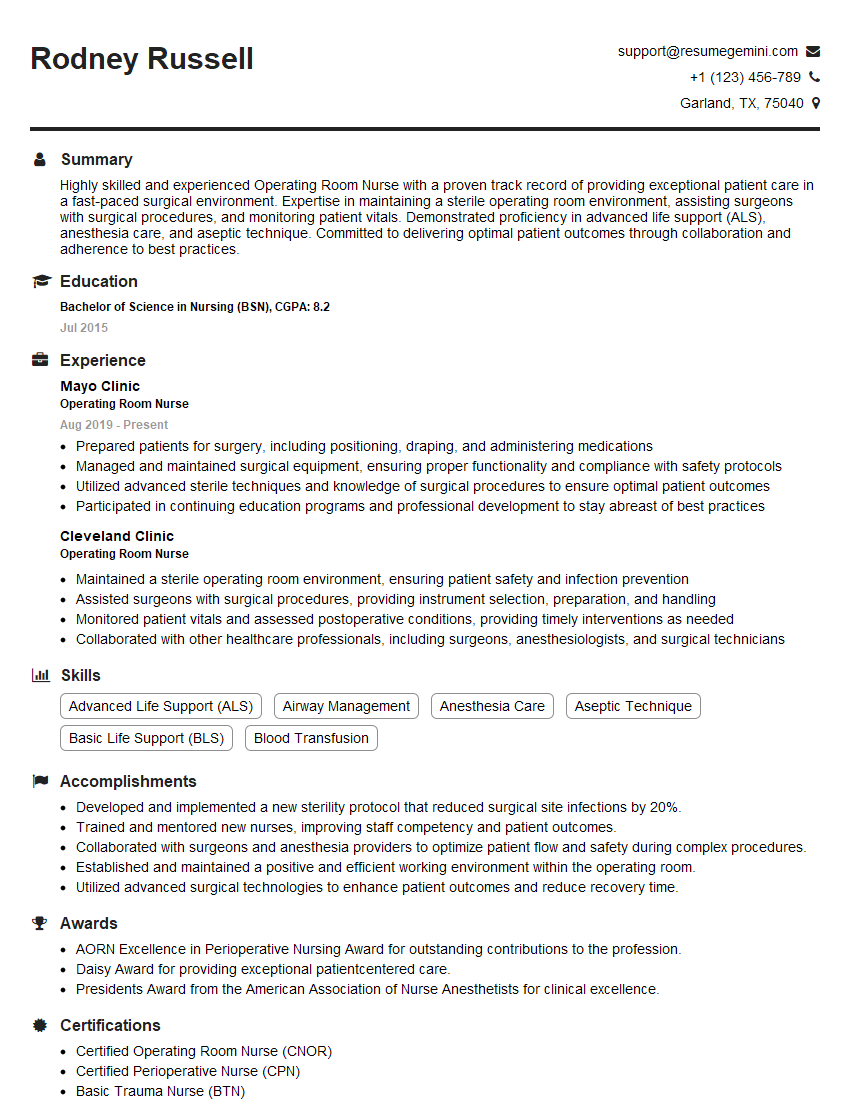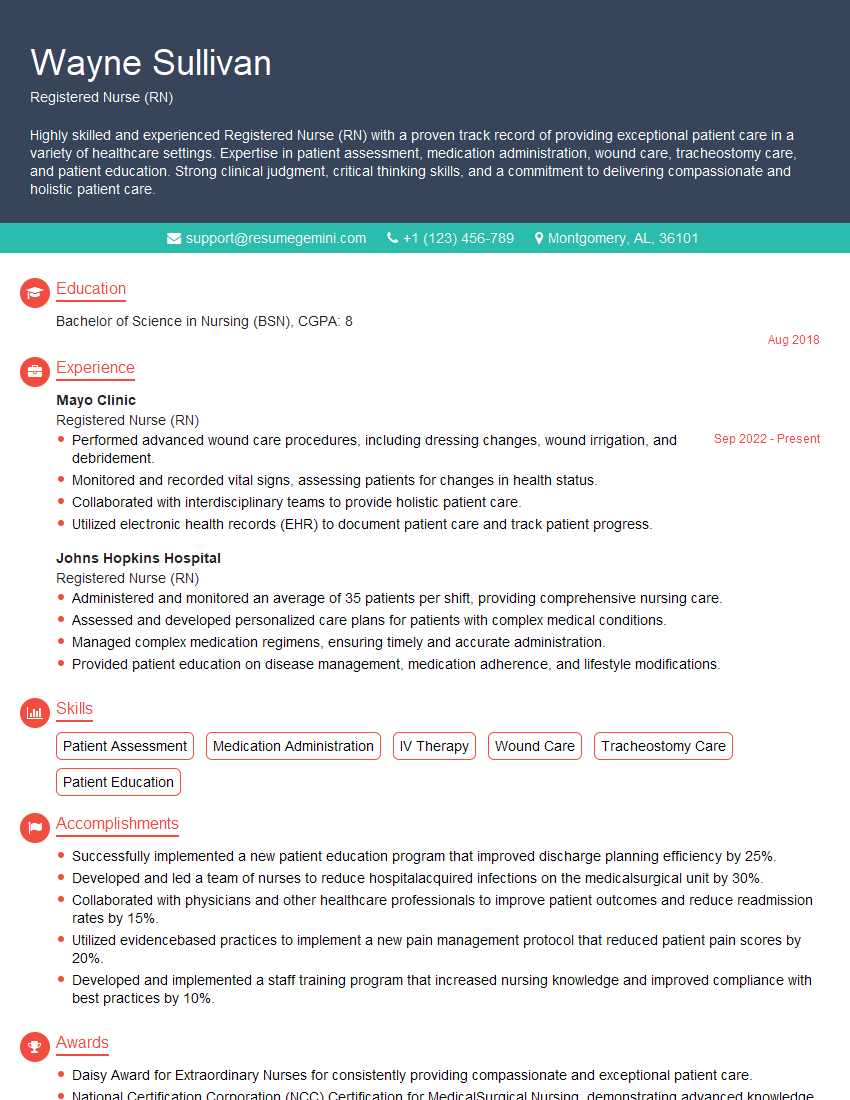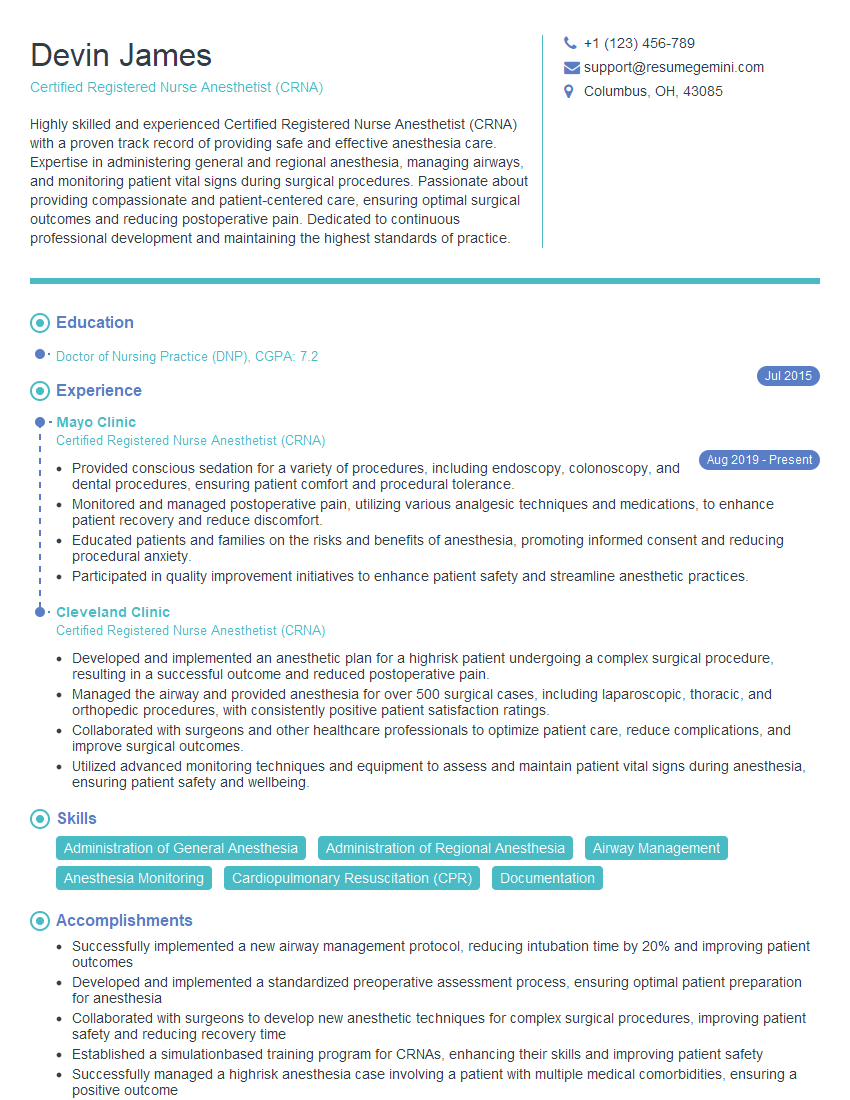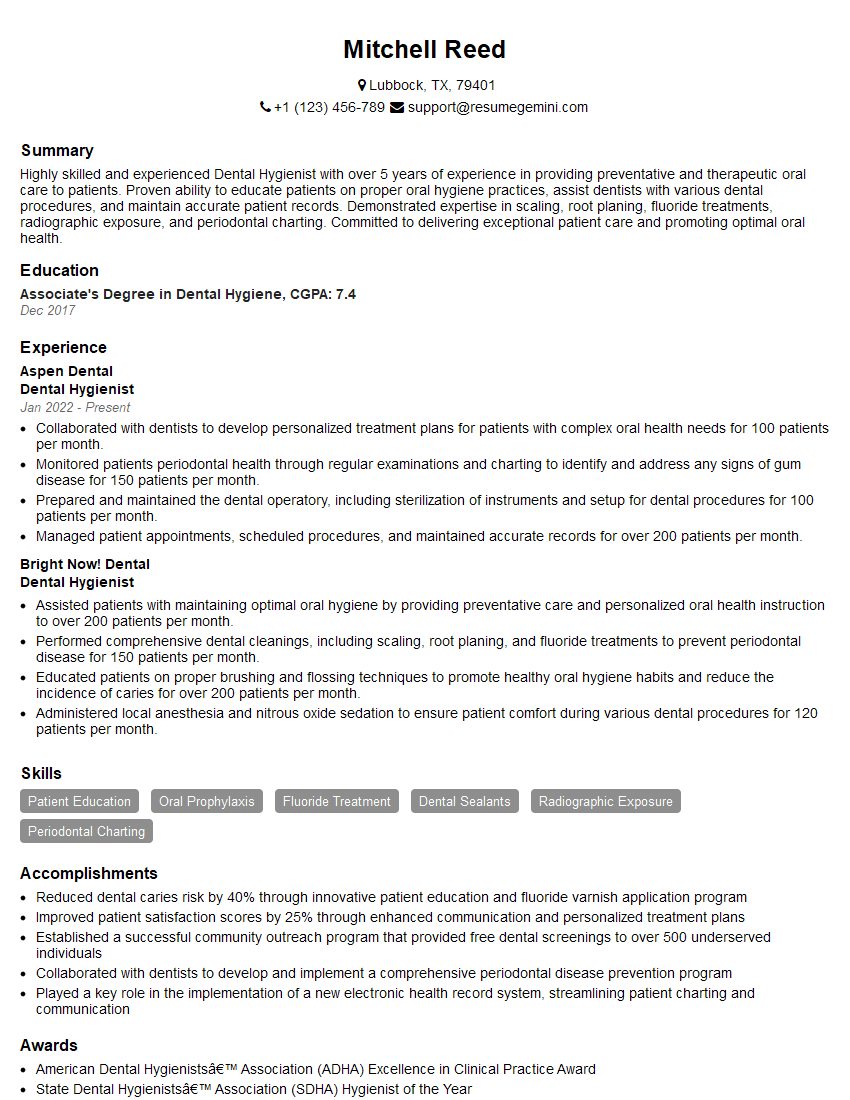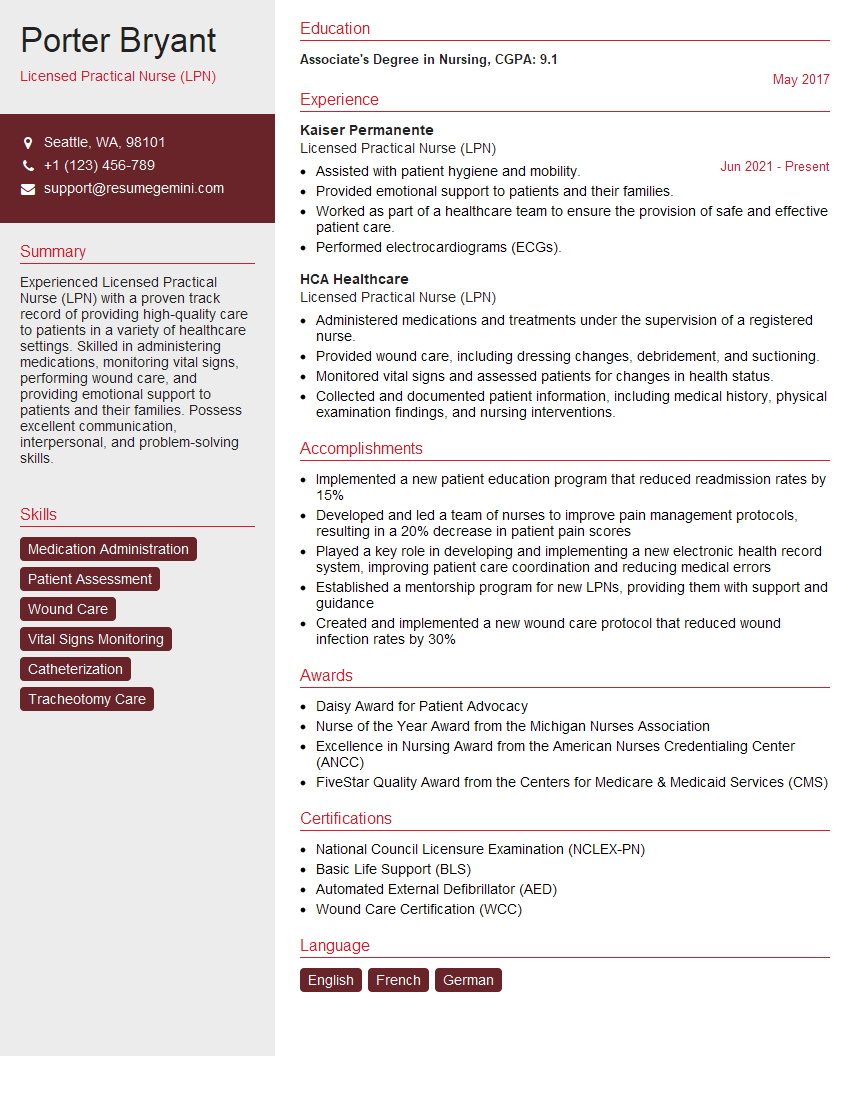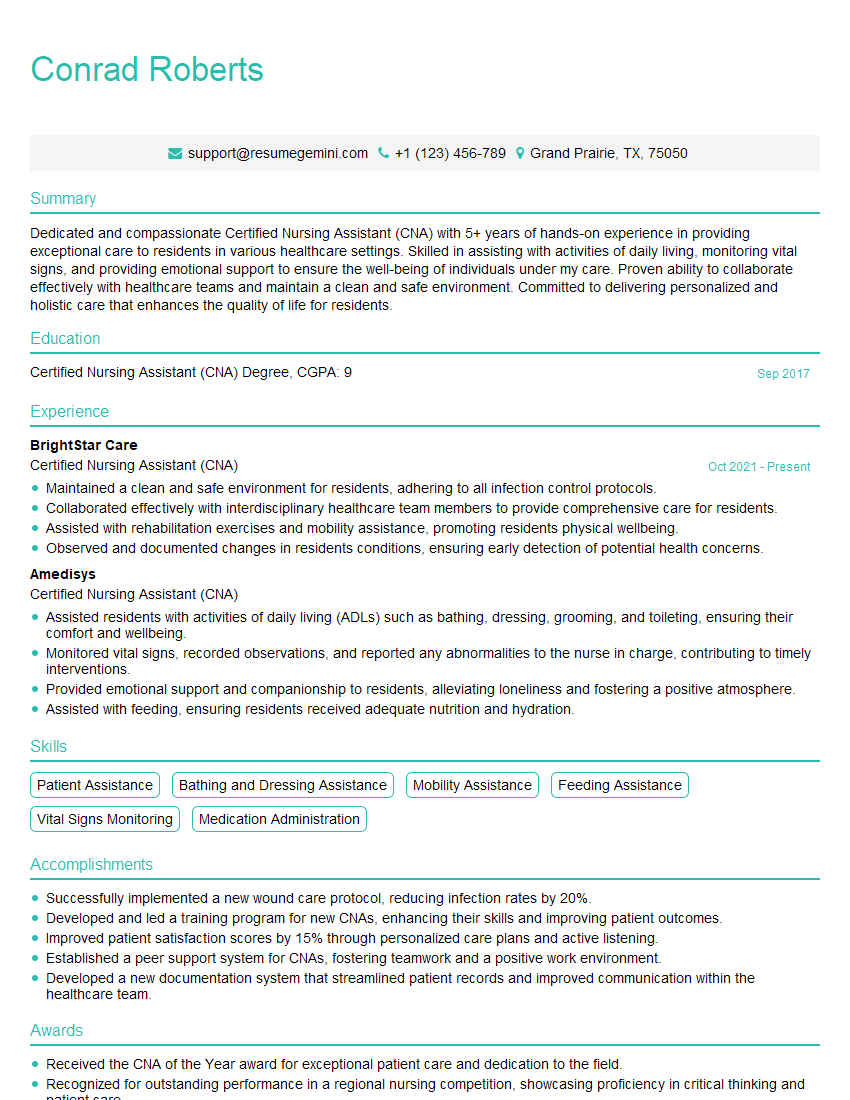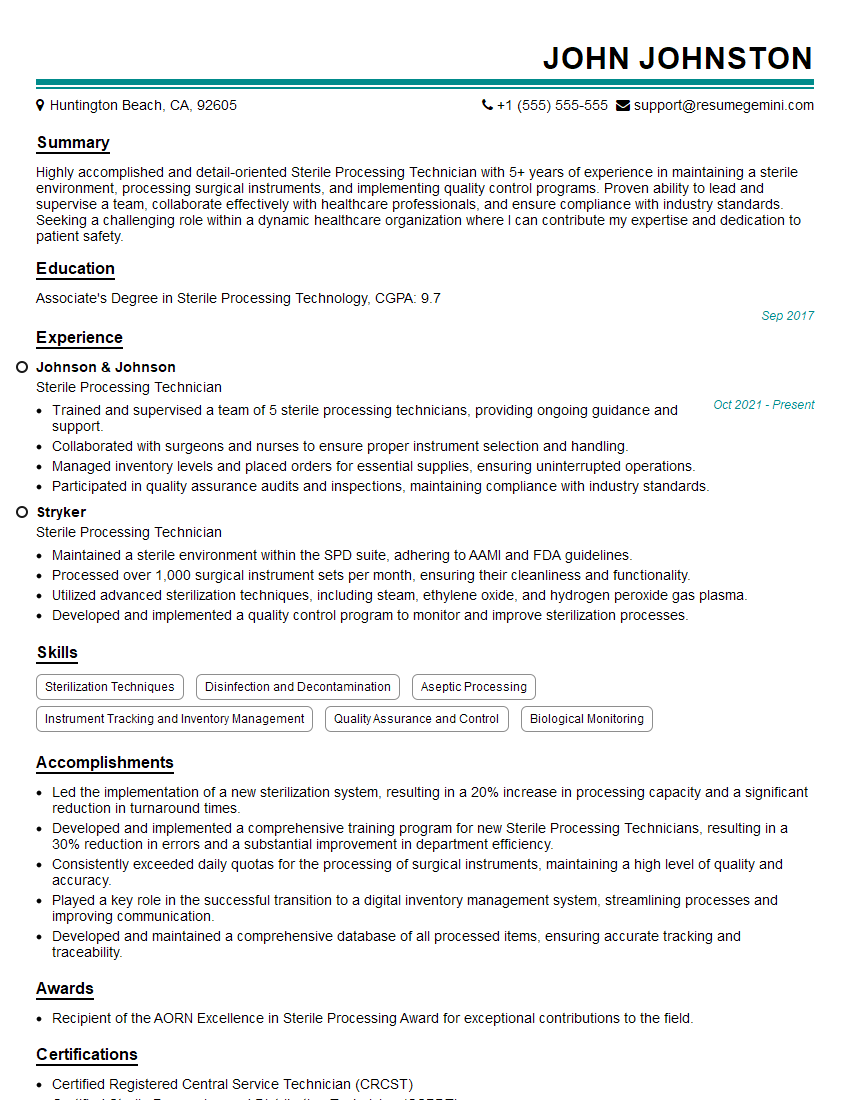Interviews are opportunities to demonstrate your expertise, and this guide is here to help you shine. Explore the essential Antiseptic Techniques interview questions that employers frequently ask, paired with strategies for crafting responses that set you apart from the competition.
Questions Asked in Antiseptic Techniques Interview
Q 1. What are the key differences between disinfection and sterilization?
Disinfection and sterilization are both crucial processes for controlling microbial contamination, but they differ significantly in their scope and effectiveness. Sterilization is the complete elimination or destruction of all forms of microbial life, including bacteria, viruses, fungi, and spores. Think of it as achieving absolute cleanliness on a microbial level. Disinfection, on the other hand, reduces the number of viable microorganisms on a surface or in a substance to a safe level, but it doesn’t necessarily kill all microorganisms, particularly resistant spores. Imagine disinfection as significantly reducing the microbial load, making something safe to handle, but not completely sterile.
For example, sterilizing surgical instruments requires techniques like autoclaving (using high-pressure steam), while disinfecting a countertop might involve using a household bleach solution. The level of cleanliness required dictates whether disinfection or sterilization is necessary.
Q 2. Describe the various levels of antiseptic agents and their applications.
Antiseptic agents are classified into various levels based on their effectiveness against different microorganisms. These levels aren’t strictly standardized across all guidelines, but generally include:
- High-level disinfectants/antiseptics: These kill vegetative bacteria, fungi, viruses, and Mycobacterium tuberculosis but may not reliably kill bacterial spores. Examples include glutaraldehyde and hydrogen peroxide.
- Intermediate-level disinfectants/antiseptics: These kill most vegetative bacteria, fungi, and some viruses, but not necessarily M. tuberculosis or spores. Isopropyl alcohol and iodophors fall into this category.
- Low-level disinfectants/antiseptics: These kill some vegetative bacteria and enveloped viruses, but are ineffective against M. tuberculosis, fungi, and spores. Quaternary ammonium compounds are a common example.
Application depends heavily on the intended use. High-level agents are used for sterilizing critical items that come into contact with sterile tissues, such as surgical instruments. Intermediate-level agents are suitable for disinfecting semi-critical items that come into contact with mucous membranes, like endoscopes. Low-level agents are used for cleaning non-critical items that touch only intact skin, such as countertops or doorknobs.
Q 3. Explain the principles of aseptic technique in surgical procedures.
Aseptic technique in surgery is a series of practices designed to create and maintain a sterile field, preventing contamination of the surgical site and instruments. The principles are built around minimizing the introduction of microorganisms into the surgical environment. This is achieved through several key steps:
- Preoperative preparation: This involves thorough cleaning and disinfection of the surgical site, using appropriate antiseptics like chlorhexidine or povidone-iodine. The patient may also receive prophylactic antibiotics.
- Surgical attire: Surgical personnel wear sterile gowns, gloves, and masks to prevent the shedding of microorganisms onto the sterile field.
- Sterile field creation: A sterile drape is used to create a barrier between the surgical site and the surrounding environment.
- Instrument sterilization: All surgical instruments are sterilized using autoclaving or other appropriate methods before use.
- Maintaining sterility: Throughout the procedure, strict adherence to aseptic technique is crucial. This includes careful handling of instruments, avoidance of unnecessary touching of the sterile field, and proper disposal of contaminated materials.
Imagine it like creating a bubble of sterility around the surgical site – every step is designed to protect this bubble from any intrusion.
Q 4. What are the common types of antiseptic solutions and their mechanisms of action?
Numerous antiseptic solutions are available, each with its own mechanism of action:
- Alcohols (e.g., isopropyl alcohol, ethanol): These disrupt cell membranes and denature proteins, leading to microbial death. They are effective against vegetative bacteria and some viruses but are not sporicidal.
- Iodophors (e.g., povidone-iodine): These release iodine, which disrupts protein synthesis and alters cell membranes. They have broad-spectrum activity, effective against bacteria, fungi, and viruses.
- Chlorhexidine: This disrupts cell membranes and precipitates cellular proteins, demonstrating effectiveness against a wide range of microorganisms.
- Hydrogen peroxide: This releases free radicals, which damage microbial cells. It’s particularly effective against anaerobes and has some sporicidal activity.
- Quaternary ammonium compounds (Quats): These disrupt cell membranes, particularly effective against Gram-positive bacteria, but less effective against Gram-negative bacteria and spores.
The choice of antiseptic depends on the specific microorganism being targeted and the site of application.
Q 5. How do you select the appropriate antiseptic for a specific clinical situation?
Selecting the appropriate antiseptic requires considering several factors:
- The type of microorganisms anticipated: Knowing the likely pathogens involved helps in choosing an antiseptic with the appropriate spectrum of activity.
- The site of application: The antiseptic must be compatible with the tissue or surface being treated. For example, some antiseptics are irritating to mucous membranes.
- The duration of contact required: The effectiveness of some antiseptics is dependent on adequate contact time.
- Patient factors: Certain patients may have allergies or sensitivities to specific antiseptics.
- The risk of infection: High-risk procedures might require more potent antiseptics.
For instance, chlorhexidine is preferred for skin disinfection before surgery due to its prolonged activity and low toxicity, while alcohol might be used for quick disinfection of a less critical surface.
Q 6. What are the potential risks and complications associated with improper antiseptic use?
Improper antiseptic use can lead to several complications:
- Ineffective infection control: Using an inappropriate antiseptic or failing to follow proper application techniques can result in incomplete microbial reduction, increasing the risk of infection.
- Allergic reactions: Some individuals may be allergic to certain antiseptics, resulting in skin reactions like rash, itching, or even anaphylaxis in severe cases.
- Toxicity: Improper use, such as overuse or application to broken skin, can lead to systemic toxicity from absorption of the antiseptic.
- Microbial resistance: Overuse of certain antiseptics can contribute to the development of resistance among microorganisms, rendering them less susceptible to treatment in the future.
- Skin irritation and damage: Some antiseptics, especially those containing alcohol or iodine, can cause irritation, dryness, and even skin damage with prolonged or improper use.
Adherence to established guidelines and protocols is vital to minimizing these risks.
Q 7. Describe the proper hand hygiene techniques for minimizing infection.
Proper hand hygiene is fundamental to preventing the spread of infections. The World Health Organization (WHO) recommends a five-step process:
- Wet your hands with water.
- Apply soap.
- Rub your hands together, covering all surfaces, for at least 20 seconds.
- Rinse your hands thoroughly under running water.
- Dry your hands with a clean towel or air dryer.
When soap and water are unavailable, an alcohol-based hand rub containing at least 60% alcohol should be used, following similar application steps. The key is thorough rubbing to ensure contact with all surfaces of the hands and fingers. Regular handwashing, especially after touching potentially contaminated surfaces and before and after patient contact, significantly reduces the risk of infection transmission in healthcare settings and the community.
Q 8. Explain the process of preparing a sterile field.
Preparing a sterile field is crucial to prevent infection during medical procedures. Think of it like creating a pristine operating room within a smaller area. It involves a series of meticulous steps to eliminate or reduce microorganisms to an acceptable level.
- Clean the surface: Begin by thoroughly cleaning the designated area with a suitable disinfectant, wiping from clean to dirty areas to avoid recontamination. Imagine washing a countertop before preparing food – same principle applies here.
- Cover the surface: A sterile drape, typically a large, absorbent cloth, is then carefully unfolded and placed to cover the work surface. Avoid touching the drape’s inner surface, which is considered sterile. Think of it like protecting a freshly baked cake from dust.
- Arrange sterile supplies: Sterile instruments and materials are added to the field, using sterile forceps and maintaining asepsis (absence of microorganisms) at all times. It’s similar to carefully setting a table with clean silverware and plates.
- Maintain sterility: Throughout the procedure, maintaining sterility is paramount. Avoid touching non-sterile items to the sterile field. Any object that falls or becomes contaminated must be immediately discarded.
Consider this scenario: a nurse is preparing an injection site. They meticulously clean the area with an antiseptic solution, then carefully place a sterile drape before drawing the medication into a sterile syringe. Maintaining the sterile field prevents the introduction of bacteria into the patient’s bloodstream.
Q 9. How do you ensure the sterility of instruments and equipment?
Ensuring sterility of instruments and equipment is achieved through sterilization – a process that eliminates all forms of microbial life. This isn’t just about making things clean; it’s about destroying even the most resilient spores. There are several methods, and the choice depends on the material and intended use.
- Sterilization Methods: Heat sterilization (autoclaving, dry heat), chemical sterilization (ethylene oxide gas, glutaraldehyde), and radiation sterilization (gamma irradiation) are common methods. Each offers specific advantages and disadvantages related to efficacy, material compatibility, and safety.
- Sterility Indicators: Sterility indicators, such as chemical indicators (color changes) and biological indicators (spore tests), are used to verify the effectiveness of the sterilization process. These indicators ensure that the process has indeed eliminated all viable microorganisms.
- Aseptic Technique: Even after sterilization, maintaining asepsis is critical. Handling sterilized items using sterile gloves and forceps prevents recontamination. Think of a perfectly baked cake – you wouldn’t want to touch it with dirty hands!
For instance, surgical instruments are typically autoclaved – heated under high pressure and steam to kill all microorganisms. Afterward, they’re stored in sterile packages until use, reinforcing the sterility. Failure to sterilize properly could lead to serious infections.
Q 10. What are the indicators of effective sterilization?
Effective sterilization is confirmed through a combination of visual checks and the use of indicators. It’s not enough to *assume* sterility; you need proof.
- Chemical Indicators: These are color-changing strips or tapes that react to specific sterilization parameters (temperature, pressure, duration). A successful color change confirms exposure to the sterilization process, but not necessarily complete sterilization. Think of them as a basic check – a pass/fail test.
- Biological Indicators: These contain resistant bacterial spores (like Geobacillus stearothermophilus for steam sterilization). After sterilization, the spores are cultured. Absence of growth indicates successful sterilization. This is the gold standard – confirming that even the hardiest microbes are eliminated. It’s like the ultimate ‘fail-safe’ to ensure complete elimination.
- Visual Inspection: Checking for any damage, tears, or breaches in packaging is also crucial. Any compromise in packaging indicates potential contamination. This is simple yet essential – ensuring that sterility remains intact.
In a hospital setting, every batch of sterilized instruments undergoes both chemical and biological indicator testing to guarantee sterility, ensuring patient safety.
Q 11. What are the different methods of sterilization and their applications?
Various sterilization methods exist, each with its own application. The choice depends on the material, heat sensitivity, and the type of microorganism to be eliminated.
- Moist Heat Sterilization (Autoclaving): Uses steam under pressure to achieve high temperatures, effective for most materials except those damaged by heat or moisture. Commonly used for surgical instruments, dressings, and liquids.
- Dry Heat Sterilization: Uses high temperatures without pressure; ideal for materials that cannot withstand moisture, like oils and powders. Used for glassware and some metal instruments.
- Ethylene Oxide Gas Sterilization: A chemical sterilization method effective for heat-sensitive items like plastics and electronics. However, it’s more complex and requires specialized equipment.
- Glutaraldehyde Sterilization: An immersion sterilization method for heat-sensitive instruments, but requires longer exposure times. Often used for endoscopes.
- Radiation Sterilization (Gamma Irradiation): Uses ionizing radiation to sterilize items. Effective but requires specialized equipment and safety precautions. Used for disposable medical devices and pharmaceuticals.
For example, a hospital might use autoclaving for surgical instruments, ethylene oxide for plastic syringes, and dry heat for glass pipettes, showcasing the versatility and necessity of different sterilization methods.
Q 12. How do you manage accidental contamination during a procedure?
Accidental contamination during a procedure is a serious event demanding immediate action. Prevention is key, but if it occurs, swift response is crucial.
- Identify and Assess: First, determine the nature and extent of contamination. Was it a sterile instrument touching a non-sterile surface, or a larger spill of non-sterile material?
- Discard Contaminated Items: Dispose of all materials suspected of being contaminated immediately, following proper waste disposal protocols. Anything that has even the slightest possibility of contact with the contaminated area needs to be discarded.
- Re-establish Sterile Field: If feasible, re-establish a sterile field and replace all contaminated items with fresh, sterile ones. This process must follow established protocols and is often overseen by experienced personnel.
- Assess Patient: Monitor the patient closely for any signs of infection, such as fever, redness, swelling, or pus. Document all incidents and communicate with the healthcare team.
Imagine a surgeon accidentally touches the sterile drape with a gloved hand that inadvertently touched a non-sterile object. The entire drape must be discarded, and a new sterile field needs to be created. The safety of the patient is the utmost priority.
Q 13. Explain the importance of environmental cleaning and disinfection in infection control.
Environmental cleaning and disinfection are cornerstones of infection control. A clean environment significantly reduces the risk of spreading infections. It’s about creating a barrier to prevent pathogens from hopping from one surface to another.
- Routine Cleaning: Regular cleaning of surfaces reduces the microbial load, removing visible dirt, debris, and organic matter. Think of this as the first layer of defense – making it difficult for harmful microbes to thrive.
- Disinfection: Disinfection uses chemical agents to kill or inactivate microorganisms on surfaces. This takes it a step further than cleaning – targeting and destroying pathogens.
- High-Level Disinfection: In high-risk areas (operating rooms), more rigorous disinfection methods are employed, sometimes achieving near-sterility. This creates a much safer environment for procedures and patients.
- Environmental Monitoring: Regular monitoring of the environment for microorganisms helps identify potential sources of contamination and assess the effectiveness of cleaning and disinfection protocols. This is the ongoing check-up – confirming that things are operating as planned.
For example, a hospital’s operating room undergoes thorough cleaning and disinfection between procedures. This includes mopping floors, wiping down equipment, and cleaning all surfaces with a suitable disinfectant, significantly reducing the chances of spreading infections.
Q 14. What are the guidelines for appropriate disposal of contaminated materials?
Appropriate disposal of contaminated materials is crucial to prevent the spread of infections. It’s the final, yet very important, step in maintaining a safe environment.
- Sharps Disposal: Needles, scalpels, and other sharp objects are placed in puncture-resistant containers to prevent injuries. This is crucial for the safety of all personnel.
- Infectious Waste Disposal: Materials contaminated with blood, body fluids, or other potentially infectious substances are segregated and disposed of according to local regulations. This usually involves special bags and procedures.
- Regular Waste Removal: Regular and frequent removal of waste from healthcare settings is important to prevent accumulation and potential hazards. This maintains a healthy environment.
- Proper Labeling: All containers containing contaminated materials must be clearly labeled to prevent accidental exposure. This is to ensure that all personnel are aware of the potentially harmful contents.
Following proper disposal protocols prevents healthcare workers from accidental needle-stick injuries and prevents the spread of infections within the facility and into the wider community. This ensures both patient and personnel safety.
Q 15. Describe the signs and symptoms of a surgical site infection (SSI).
Surgical site infections (SSIs) are infections that occur after surgery in the part of the body where the surgery took place. They can range from minor to life-threatening. Recognizing the signs and symptoms is crucial for prompt treatment.
- Localized signs: These are usually observed at the surgical site itself. They include redness, swelling, pain, warmth to the touch, pus or drainage, and increased tenderness.
- Systemic signs: These indicate a more widespread infection. They can manifest as fever, chills, increased heart rate, fatigue, and generally feeling unwell. Sometimes, there’s even elevated white blood cell count, detectable through blood tests.
- Delayed onset: SSIs can appear anywhere from a few days to several weeks post-surgery. Early recognition is vital, as the timing can be deceptive.
For example, a patient might present with a red, swollen incision site, accompanied by fever and chills, several days after abdominal surgery. This would strongly suggest an SSI.
Career Expert Tips:
- Ace those interviews! Prepare effectively by reviewing the Top 50 Most Common Interview Questions on ResumeGemini.
- Navigate your job search with confidence! Explore a wide range of Career Tips on ResumeGemini. Learn about common challenges and recommendations to overcome them.
- Craft the perfect resume! Master the Art of Resume Writing with ResumeGemini’s guide. Showcase your unique qualifications and achievements effectively.
- Don’t miss out on holiday savings! Build your dream resume with ResumeGemini’s ATS optimized templates.
Q 16. What are the strategies for preventing SSIs?
Preventing SSIs is a multi-faceted approach encompassing meticulous antiseptic techniques and adherence to strict protocols. Here are some key strategies:
- Preoperative skin preparation: This involves thorough cleansing and disinfection of the surgical site with appropriate antiseptic agents like chlorhexidine or iodophors, following established guidelines. Different protocols exist depending on the surgical procedure.
- Maintaining sterile technique during surgery: This is paramount and involves all members of the surgical team adhering to strict sterile protocols, including proper hand hygiene, gowning, gloving, and instrument sterilization.
- Postoperative wound care: This includes careful dressing changes, monitoring for signs of infection, and providing appropriate antibiotic prophylaxis when indicated. Meticulous wound care greatly reduces the risk of infection.
- Patient education: Educating patients about the importance of hygiene, wound care, and recognizing signs of infection is vital for successful prevention.
- Optimizing patient health: Factors such as controlling blood glucose levels in diabetic patients and addressing other underlying health conditions can significantly reduce the risk.
Think of it like building a fortress against infection: each strategy reinforces the others, creating a strong barrier to infection.
Q 17. How do you monitor the effectiveness of antiseptic protocols?
Monitoring the effectiveness of antiseptic protocols requires a combination of surveillance and data analysis. It’s not just about the number of SSIs, but also the quality of the process itself.
- SSI surveillance: Tracking the incidence of SSIs within the healthcare facility is crucial. This involves systematically identifying and recording cases, categorizing them by type and location, and analyzing trends over time.
- Auditing antiseptic techniques: Regular audits of surgical procedures are essential to identify any deviations from established protocols. This could involve reviewing surgical records, observing surgical practices, and conducting staff training evaluations.
- Environmental monitoring: Periodically assessing the cleanliness and sterility of the surgical environment, including air quality and surface disinfection, can identify potential sources of contamination.
- Antimicrobial susceptibility testing: When an SSI occurs, identifying the causative organism and its susceptibility to various antibiotics is important for treatment and to potentially identify patterns of resistance within the hospital.
For example, a consistent increase in a particular type of SSI could indicate a weakness in a specific aspect of the antiseptic protocol, prompting a review and adjustment of the procedures.
Q 18. Explain the role of personal protective equipment (PPE) in infection prevention.
Personal Protective Equipment (PPE) is crucial in infection prevention by creating a physical barrier between healthcare workers and potential sources of infection, protecting both the patient and the healthcare provider.
- Gowns: Provide a barrier to protect clothing from contamination with body fluids and other potentially infectious material.
- Gloves: Protect hands from direct contact with blood, body fluids, and contaminated surfaces.
- Masks and respirators: Prevent inhalation of airborne pathogens.
- Eye protection: Shields eyes from splashes and sprays of body fluids.
Imagine PPE as a suit of armor, shielding healthcare workers during interactions with potentially infectious materials. Proper use and disposal of PPE are vital components of effective infection control.
Q 19. What is the significance of Standard Precautions and Transmission-Based Precautions?
Standard Precautions and Transmission-Based Precautions are the cornerstones of infection control. They represent a hierarchical approach to minimizing the risk of infection transmission.
- Standard Precautions: These are applied to all patients, regardless of their infection status. They involve practices such as hand hygiene, proper use of PPE, safe injection practices, and safe handling of sharps.
- Transmission-Based Precautions: These are additional precautions implemented for patients known or suspected to be infected with specific pathogens, categorized by their mode of transmission (airborne, droplet, contact). Examples include wearing a respirator for airborne precautions or using contact precautions for patients with C. difficile.
Standard Precautions are the foundation, while Transmission-Based Precautions provide extra layers of protection based on the specific risk.
Q 20. Describe your experience with different antiseptic agents (e.g., alcohols, iodophors, chlorhexidine).
My experience encompasses a wide range of antiseptic agents, each with its strengths and limitations. The choice of agent depends on various factors, including the type of procedure, the patient’s skin condition, and the specific microorganism targeted.
- Alcohols (e.g., isopropyl alcohol, ethanol): Rapid-acting and effective against a broad range of microorganisms, but their activity is reduced by the presence of organic matter. They are generally well-tolerated but can cause skin dryness with prolonged use.
- Iodophors (e.g., povidone-iodine): Broad-spectrum activity, persistent antimicrobial effect, and relatively low toxicity. However, they can stain skin and some individuals may be allergic to iodine.
- Chlorhexidine gluconate: Persistent activity, effective against a wide range of bacteria and fungi, and exhibits low toxicity. It’s often preferred for skin antisepsis, but its activity can be compromised by the presence of soap.
I’ve personally found chlorhexidine to be particularly effective in reducing SSIs in many surgical procedures, but proper selection and application techniques are crucial for optimal effectiveness.
Q 21. Explain the concept of surgical asepsis versus medical asepsis.
Surgical asepsis and medical asepsis are two distinct levels of asepsis, representing different approaches to minimizing the risk of infection.
- Surgical asepsis: Also known as sterile technique, aims to eliminate all microorganisms from a specific area. It’s crucial for procedures involving entry into the body’s sterile cavities (e.g., surgery, catheter insertion). Every step is designed to prevent contamination.
- Medical asepsis: Also known as clean technique, involves reducing the number of microorganisms to a safe level. It’s used in many clinical settings (e.g., wound dressing changes, medication administration). While it doesn’t eliminate all microorganisms, it minimizes the risk of infection significantly.
Think of it like this: surgical asepsis is like creating a completely sterile environment, while medical asepsis is about reducing the microbial load to a safe level. Both are essential for preventing infections.
Q 22. What are the challenges in maintaining aseptic techniques in various healthcare settings?
Maintaining aseptic techniques across diverse healthcare settings presents a multifaceted challenge. It’s like trying to keep a pristine laboratory environment in a bustling city – constant vigilance is required. The challenges stem from several sources:
- High patient volume and workload: In busy hospitals or clinics, the pressure to see patients quickly can sometimes compromise the thoroughness of antiseptic procedures. Time constraints can lead to shortcuts.
- Resource limitations: Adequate supplies of antiseptic agents, personal protective equipment (PPE), and appropriate sterilization equipment aren’t always readily available, particularly in resource-limited settings.
- Staff training and competency: Inconsistent or inadequate training on proper antiseptic techniques can lead to errors and lapses in adherence to protocols. Regular refresher courses and competency assessments are crucial.
- Environmental factors: The healthcare environment itself can harbor microorganisms. Effective cleaning and disinfection of surfaces, equipment, and the air are crucial to minimize contamination. This is especially relevant in operating rooms and intensive care units (ICUs).
- Patient-related factors: Patients themselves can introduce microorganisms, especially those with compromised immune systems or colonized with resistant organisms. Careful hand hygiene and appropriate isolation precautions are essential.
Addressing these challenges requires a multi-pronged approach involving improved resource allocation, comprehensive staff training programs, robust infection control protocols, and a commitment to continuous quality improvement.
Q 23. How do you handle resistant organisms in relation to antiseptic strategies?
Dealing with resistant organisms requires a shift from a reactive to a proactive strategy. It’s like fighting a sophisticated enemy that constantly adapts – we need advanced weaponry and strategic planning. The approach includes:
- Strict adherence to infection control guidelines: This includes meticulous hand hygiene, appropriate use of PPE, proper sterilization of equipment, and environmental disinfection.
- Targeted antimicrobial therapy: Antibiotic stewardship programs are vital to prevent the overuse and misuse of antibiotics, which contribute to resistance. Susceptibility testing is crucial to guide antibiotic selection.
- Infection prevention and control strategies: This includes contact precautions, cohorting of patients with the same resistant organism, and environmental cleaning with disinfectants effective against the specific organism.
- Implementing infection control surveillance: Regular monitoring of resistant organism prevalence allows for early detection and rapid response to outbreaks.
- Exploring alternative antiseptic agents: Research into novel antiseptic agents with different mechanisms of action is essential to overcome resistance to commonly used agents. This includes exploring natural antimicrobials and innovative formulations.
The key is to move beyond simply treating infections to preventing them. This requires a combination of individual actions and systemic changes within the healthcare system.
Q 24. How do you interpret the results of microbiological testing related to sterilization and disinfection?
Interpreting microbiological test results related to sterilization and disinfection is crucial for ensuring the safety and effectiveness of procedures. It’s like decoding a secret message to ensure everything is functioning as expected. The interpretation involves several key steps:
- Understanding the test method: Different methods assess different aspects of sterilization or disinfection (e.g., sterility testing, bioburden determination, efficacy testing against specific organisms).
- Assessing the results in context: A positive result on a sterility test indicates contamination, but the level of contamination and its potential impact need to be considered. Similarly, a disinfectant might demonstrate effectiveness against some organisms but not others.
- Considering the limitations of testing: No test is perfect; false negatives and false positives can occur. The interpretation needs to account for the inherent limitations of the method.
- Comparing results to established standards: Results should be compared to relevant regulatory standards and guidelines (e.g., those from the FDA or other relevant bodies) to determine compliance.
- Implementing corrective actions: If the results indicate a problem, appropriate corrective actions need to be taken, such as reviewing sterilization protocols, replacing faulty equipment, or retraining staff.
For example, if a sterility test shows bacterial growth after sterilization, a thorough investigation is needed to identify the source of contamination and to rectify the process. It might be a faulty sterilizer, improper packaging, or a lapse in technique.
Q 25. What are some emerging technologies and advancements in antiseptic techniques?
The field of antiseptic techniques is constantly evolving. We’re seeing some exciting new developments, which can be seen as advancements in our arsenal to fight against infections. This includes:
- Nanotechnology: Nanomaterials are being explored for their antimicrobial properties, offering potentially more effective and targeted approaches to disinfection.
- Photodynamic therapy (PDT): This technique uses light-activated antimicrobial agents to kill microorganisms, offering a non-toxic alternative in some cases.
- Plasma sterilization: Plasma technology utilizes ionized gas to sterilize materials, providing a rapid and effective method for certain applications.
- Improved antiseptic formulations: Research is ongoing to develop novel antiseptic formulations with enhanced efficacy, broader antimicrobial spectrum, and reduced toxicity.
- Artificial intelligence (AI): AI algorithms can be used to analyze data from infection control surveillance systems to predict outbreaks and optimize disinfection strategies.
These emerging technologies hold great promise for improving infection control and patient safety but require rigorous testing and evaluation before widespread adoption.
Q 26. Describe your understanding of the Centers for Disease Control and Prevention (CDC) guidelines on infection control.
The CDC guidelines on infection control provide a comprehensive framework for preventing healthcare-associated infections. They’re like the constitution of infection control, guiding principles for maintaining a safe and healthy environment. My understanding encompasses:
- Hand hygiene: The cornerstone of infection control, emphasizing proper handwashing techniques and the use of alcohol-based hand rubs.
- Personal protective equipment (PPE): Appropriate use of PPE, including gloves, gowns, masks, and eye protection, to prevent exposure to infectious agents.
- Environmental disinfection: Regular cleaning and disinfection of surfaces and equipment to minimize the spread of microorganisms.
- Sterilization techniques: Proper methods for sterilizing medical instruments and equipment to eliminate all microorganisms.
- Isolation precautions: Appropriate isolation techniques for patients with infectious diseases to prevent transmission to others.
- Surveillance and outbreak management: Systems for monitoring infection rates, identifying outbreaks, and implementing control measures.
The guidelines are regularly updated to reflect current scientific evidence and best practices. Adherence to these guidelines is essential for minimizing the risk of healthcare-associated infections.
Q 27. How do you stay updated on current best practices for antiseptic techniques?
Staying updated on best practices in antiseptic techniques is an ongoing process. It’s like constantly upgrading your software to keep it running efficiently. My approach includes:
- Regularly reviewing peer-reviewed journals and publications: Staying abreast of the latest research findings and clinical guidelines published in reputable journals such as the Infection Control & Hospital Epidemiology and the American Journal of Infection Control.
- Attending professional conferences and workshops: Participating in conferences and workshops provides opportunities to learn from experts and network with colleagues.
- Following reputable professional organizations: Organizations such as the Association for Professionals in Infection Control and Epidemiology (APIC) and the Society for Healthcare Epidemiology of America (SHEA) offer valuable resources and updates on best practices.
- Participating in continuing education activities: Engaging in continuing education courses keeps my knowledge and skills current.
- Monitoring relevant regulatory updates: Staying informed about changes in regulations and guidelines from agencies such as the CDC and FDA.
A commitment to lifelong learning is crucial in this rapidly evolving field.
Q 28. Explain a time you had to troubleshoot a problem related to maintaining aseptic technique.
During my time at a busy urban hospital, we experienced a sudden increase in surgical site infections (SSIs) following a specific type of orthopedic surgery. It was like investigating a crime scene to find the source of contamination. The initial response included:
- Review of surgical protocols: We carefully reviewed the surgical technique, including the preparation of the surgical site, use of antiseptic solutions, and draping procedures.
- Assessment of sterilization processes: We inspected the sterilization equipment and reviewed the sterilization logs to identify any potential issues with the sterilization process.
- Microbiological testing: We conducted microbiological cultures of surgical instruments, drapes, and surgical site samples to identify the causative organisms and determine their antibiotic susceptibility.
- Staff training and competency assessment: We reassessed the staff’s knowledge and skills in maintaining aseptic techniques and conducted refresher training sessions.
- Environmental monitoring: We conducted environmental monitoring to identify any potential sources of contamination in the operating room.
The investigation revealed that a new batch of surgical drapes had inadequate sterility assurance. Once we switched to a different supplier, the SSI rate returned to normal levels. This experience highlighted the importance of meticulous attention to detail in all aspects of surgical asepsis, the need for robust quality control measures and the importance of a systematic approach to troubleshooting.
Key Topics to Learn for Antiseptic Techniques Interview
- Principles of Antisepsis: Understanding the mechanisms of action of different antiseptic agents (e.g., alcohols, halogens, quaternary ammonium compounds) and their effectiveness against various microorganisms.
- Selection of Antiseptics: Factors influencing the choice of antiseptic, including the type of infection, site of application, patient factors (e.g., allergies, age), and cost-effectiveness. Practical application: Discussing scenarios requiring specific antiseptic choices.
- Application Techniques: Mastering proper techniques for applying antiseptics to various body sites (e.g., skin, mucous membranes, wounds) to ensure maximal efficacy and minimize irritation. Includes understanding appropriate contact time and preparation methods.
- Infection Control Protocols: Familiarity with standard infection control procedures and guidelines, including hand hygiene, personal protective equipment (PPE) usage, and waste disposal. Problem-solving: Analyzing scenarios involving breaches in infection control protocols.
- Antiseptic Resistance: Understanding the mechanisms of antimicrobial resistance and strategies to mitigate its development and spread. This includes exploring the impact of overuse and misuse of antiseptics.
- Surveillance and Evaluation: Knowledge of methods for monitoring the effectiveness of antiseptic practices and identifying areas for improvement. Practical application: Describing relevant data collection and analysis techniques.
- Legal and Ethical Considerations: Understanding relevant regulations and ethical guidelines related to antiseptic use and patient safety. This includes patient consent and informed decision-making processes.
Next Steps
Mastering antiseptic techniques is crucial for a successful and rewarding career in healthcare. A strong understanding of these principles demonstrates commitment to patient safety and contributes to a positive work environment. To significantly improve your job prospects, create an ATS-friendly resume that highlights your skills and experience effectively. ResumeGemini is a trusted resource that can help you build a professional and impactful resume. Examples of resumes tailored to antiseptic techniques are available through ResumeGemini to guide you through the process, helping you present your qualifications convincingly and land your dream role.
Explore more articles
Users Rating of Our Blogs
Share Your Experience
We value your feedback! Please rate our content and share your thoughts (optional).
What Readers Say About Our Blog
This was kind of a unique content I found around the specialized skills. Very helpful questions and good detailed answers.
Very Helpful blog, thank you Interviewgemini team.
